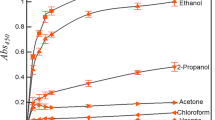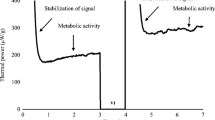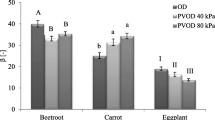Abstract
The effects of vacuum acidification (VA) and pulsed vacuum acidification (PVA) on pH reduction and their kinetics on carrot and eggplant slices were studied. Both vegetables showed a significant improvement of acidification rate when submitted to VA and PVA in comparison with traditional acidifying-dipping. In particular, carrot slices treated at 1,023.25 and 300 mbar showed kinetic constants of “Peleg-type model,” respectively, of 163.11 ± 108.4 and 31.86 ± 11.15 min−1 proving a significant increase of initial rate when a vacuum pulse was applied. Nevertheless, a further increase of vacuum did not improve pH reduction due to the low-porosity and the high-rigidity tissues. For eggplants submitted to VA, a fractional decrease of pH of 20 % was obtained by applying a pressure of 100 mbar for a vacuum time of 3 min and a relaxation time of 5 min; instead, only a reduction of 3 % was obtained at atmospheric pressure. Furthermore, the changes on visual appearance of vegetable tissue were highlighted, showing that the inhomogeneous response of eggplants to the vacuum in different sections of the slices could reduce the consumers’ acceptability.





Similar content being viewed by others
References
Andres, I., Salvatori, D., Chiralt, A., & Fito, P. (2001). Vacuum impregnation viability of some fruits and vegetables. In P. Fito, A. Chiralt, J. M. Barat, W. E. L. Spiess, D. Behsnilian, & D. Behsnilian (Eds.), Vacuum impregnation viability of some fruits and vegetables. Boca Raton: CRC.
Barat, J. M., Fito, P., & Chiralt, A. (2001). Modeling of simultaneous mass transfer and structural changes in fruits tissues. Journal of Food Engineering, 49, 77–85.
Betoret, N., Puente, L., Diaz, M. J., Pagan, M. J., Garcia, M. J., Gras, M. L., et al. (2003). Development of probiotic-enriched dried fruits by vacuum impregnation. Journal of Food Engineering, 56, 273–277.
Chiralt, A., & Fito, P. (2003). Transport mechanisms in osmotic dehydration: the role of the structure. Food Science and Technology International, 9, 179–186.
Chiralt, A., Fito, P., Barat, J. M., Andres, A., Gonzales-Martinez, C., Escriche, I., et al. (2001). Use of vacuum impregnation in food salting process. Journal of Food Engineering, 49, 141–151.
Corzo, O., Brancho, N., Rodriguez, J., & Gonzales, M. (2007). Predicting the moisture and salt contents of sardine sheets during vacuum pulse osmotic dehydration. Journal of Food Engineering, 80, 781–790.
Cruz, R. M. S., Vieira, M. C., & Silva, C. L. M. (2009). The response of watercress (Nasturtium officinale) to vacuum impregnation: effect of an antifreeze protein type I. Journal of Food Engineering, 95, 339–345.
Derossi, A., De Pilli, T., & Severini, C. (2010). Reduction in the pH of vegetables by vacuum impregnation: a study on pepper. Journal of Food Engineering, 99, 9–15.
Derossi, A., De Pilli, T., La Penna, M. P., & Severini, C. (2011). pH reduction and vegetable tissue changes of zucchini during pulsed vacuum acidification. LWT- Food Science and Technology, 44, 1901–1907.
Derossi, A., Fiore, A. G., De Pilli, T., & Severini, C. (2011). A review on acidifying treatments for vegetables canned food. Critical Review in Food Science and Nutrition, 51, 955–964.
Fito, P. (1994). Modeling of vacuum osmotic dehydration of food. Journal of Food Engineering, 22, 313–328.
Fito, P., & Pastor, R. (1994). Non-diffusional mechanism occurring during vacuum osmotic dehydration (VOD). Journal of Food Engineering, 21, 513–519.
Fito, P., Andres, A., Chiralt, A., & Pardo, P. (1996). Coupling of hydrodynamic mechanism and deformation-relaxation phenomena during vacuum treatments in solid porous food-liquid systems. Journal of Food Engineering, 27, 229–240.
Fito, P., Chiralt, A., Betoret, N., Gras, M., Chafer, M., & Martinez-Monzo, J. (2001). Vacuum impregnation and osmotic dehydration in matrix engineering: application in functional fresh food development. Journal of Food Engineering, 49, 175–183.
Food and Drug Administration. (2002). Code of Federal Regulation title 21 (vol2). 21CFR114. Washington, DC: US Government Printing Office.
Giraldo, G., Talens, P., Fito, P., & Chiralt, A. (2003). Influence of sucrose solution concentration on kinetics and yield during osmotic dehydration of mango. Journal of Food Engineering, 58, 33–43.
Gras, M., Vidal-Brotons, D., Betoret, N., Chiralt, A., & Fito, P. (2002). The response of some vegetables to vacuum impregnation. Innovative Food Science and Emerging Technology, 3, 263–269.
Gras, M. L., Vidal, D., Betoret, N., Chiralt, A., & Fito, P. (2003). Calcium fortification of vegetables by vacuum impregnation: interaction with cellular matrix. Journal of Food Engineering, 28, 279–284.
Guillemin, A., Degraeve, P., Noel, C., & Saurel, R. (2008). Influence of impregnation solution viscosity and osmolarity on solute uptake during vacuum impregnation of apple cubes (var. granny Smith). Journal of Food Engineering, 86, 475–483.
Hironaka, K., Kikuchi, M., Koaze, H., Sato, T., Kojima, M., Yamamoto, K., et al. (2011). Ascorbic acid enrichment of whole potato tuber by vacuum-impregnation. Food Chemistry, 127, 1114–1118.
Hofmeister, L. C., Souza, J. A. R., & Laurindo, J. B. (2005). Use of dyed solutions to visualize different aspects of vacuum impregnation of Minas cheese. LWT- Food Science and Technology, 38, 379–386.
Lewis, M. J. (1993). Propiedades fisicas de los alimentos y de los sistemas de procesado. Ed. Acribia, Zaragoza, Espana.
Martinez, M. V., & Whitaker, J. R. (1995). The biochemistry and control of enzymatic browning. Trends in Food Science and Technology, 6, 195–200.
Martinez-Monzo, J., Martinez-Navarrete, N., Chiralt, A., & Fito, P. (1998). Mechanical and structural change in apple (var Granny Smith) due to vacuum impregnation with cryoprotectans. Journal of Food Science, 63, 499–503.
Montville, T. J., & Matthews, K. R. (2005). Food microbiology: an introduction. Washington: American Society for Microbiology.
Mujica-Paz, H., Valdez-Fragoso, A., Lopez-Malo, A., Palou, E., & Welti-Chanes, J. (2002). Impregnation properties of some fruits at vacuum pressure. Journal of Food Engineering, 56, 307–314.
Mujica-Paz, H., Valdez-Fragoso, A., Lopez-Malo, A., Palou, E., & Welti-Chanes, J. (2003). Impregnation and osmotic dehydration of some fruits: effect of the vacuum pressure and syrup concentration. Journal of Food Engineering, 57, 305–314.
New York State Agricultural experimental Station The North-east Center for Food Enterpreneurship at the New York State Food Venture Center. (2011). Cornell University, New York. Available at: www.nysaes.cornell.edu/necfe/pubs/pdf/FactSheets/FS_AcidifiedFoods.pdf. Accessed 20 November 2011.
Peleg, M. (1988). An empirical model for the description of moisture sorption curves. Journal of Food Science, 55, 1084–1087.
Ponappa, T., Scheerens, J. C., & Miller, A. R. (1993). Vacuum infiltration of polyamines increases firmness of strawberry slices under various storage conditions. Journal of Food Science, 58, 361–364.
Sacchetti, G., Gianotti, A., & Dalla Rosa, M. (2001). Sucrose-salt combined effects on mass transfer kinetics and product acceptability. Study on apple osmotic treatments. Journal of Food Engineering, 49, 163–173.
Salvatori, D., Andres, A., Chiralt, A., & Fito, P. (1998). The response of some properties of fruits to vacuum impregnation. Journal of Food Engineering, 21, 59–73.
Silva-Paes, S., Stringari, G. B., & Laurindo, J. B. (2007). Effect of vacuum and relaxation periods and solution concentration on the osmotic dehydration of apples. International Journal of Food Science and Technology, 42, 441–447.
Smith, A. D., Stratton, J. E. (2007). Acidified foods: food processing for entrepreneurs series. Institute of Agricultural and Natural Resources, University of Nebraska Lincoln.
Xie, J., & Zhao, Y. (2003). Improvement of physicochemical and nutritional qualities of frozen Marioberry by vacuum impregnation pretreatment with cryoprotectants and minerals. Journal of Horticultural Science, 78, 248–253.
Zhao, Y., & Xie, J. (2004). Practical application of vacuum impregnation in fruit and vegetable processing. Trends in Food Science & Technology, 15, 434–451.
Conflict of interest
The authors declare that they have no actual or potential conflict of interest including financial, personal, or other relationships with other people or organizations within 3 years from the beginning the submitted work that could inappropriately influence, or be perceived to influence, their work. This paper has not been published previously, and it is not under consideration for publication elsewhere. Moreover, the text is approved by all authors and tacitly or explicitly by the responsible authorities where the work was carried out and that, if accepted, it will not be published elsewhere including electronically in the same form, in English or in any other language, without the written consent of the copyright holder.
Author information
Authors and Affiliations
Corresponding author
Rights and permissions
About this article
Cite this article
Derossi, A., De Pilli, T. & Severini, C. Application of Vacuum Impregnation Techniques to Improve the pH Reduction of Vegetables: Study on Carrots and Eggplants. Food Bioprocess Technol 6, 3217–3226 (2013). https://doi.org/10.1007/s11947-012-0994-3
Received:
Accepted:
Published:
Issue Date:
DOI: https://doi.org/10.1007/s11947-012-0994-3




